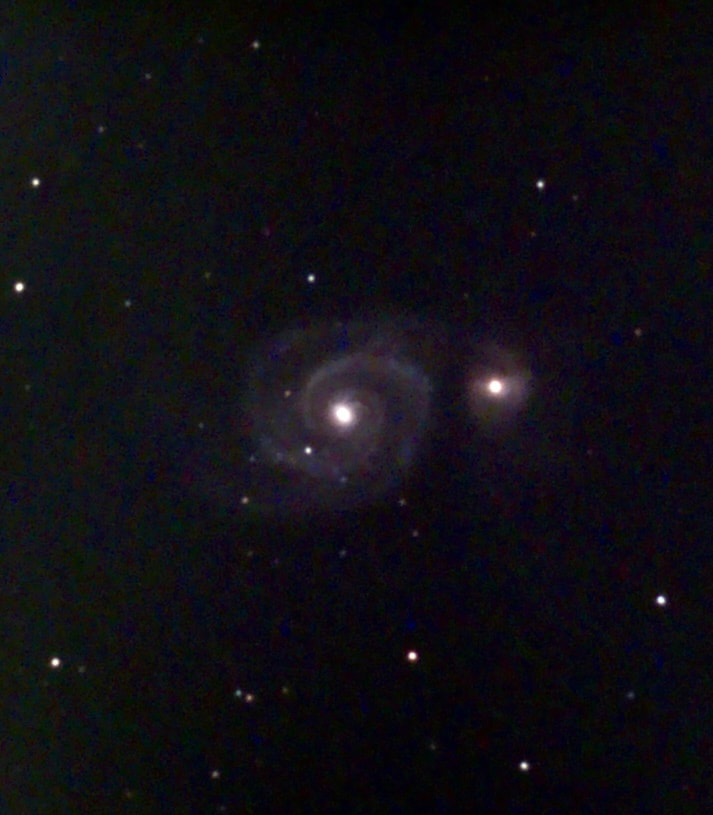|
It seems that the cloudy, turbulent days of winter - in more ways than one - are finally coming to an end. In the wee hours of March 20th, the sky was clear, transparency was (supposed to be) high, and seeing was about average. Conditions, in other words, were about as good as we've had in months. I trotted out with my EVScope, intent on imaging some of the deep space wonders that are now prominent in the early modern sky. After a lightning-quick setup, as usual, I directed my attention to M51, the Whirlpool Galaxy, which is colliding with (and ripping apart) NGC 5195, a smaller galaxy. After a seven-minute exposure, the results impressed me - and for once I noticed that the image looked better when I peered through the eyepiece. Two other galaxies beckoned around the same constellation (Ursa Major, or the Big Dipper): Bode's Galaxy (M81) and the Pinwheel Galaxy (M101). Both are much trickier targets. Bode's bright core is easy to find, but its spiral arms are easily lost; the Pinwheel is big, but has generally low surface brightness. While transparency was supposed to be high, the sky was actually remarkably bright, and I noticed clear halos around street lamps. If anything conditions promised to be poor for both galaxies, and sure enough I wasn't pleased with the results. Here's a three-minute exposure of the Pinwheel Galaxy; you'll see it doesn't exactly impress. That's the thing with the EVScope, and something I haven't seen mentioned in any review: like all telescopes, it performs much better under a dark sky. While there's a lot of hype about how it will reveal deep space objects in the middle of the city, that promise holds up much better for objects that are already bright. Fainter objects can be lost in the glare of light pollution, just as they are in traditional optical telescopes. I'll try these galaxies again when conditions are better, but I don't expect radically different results. By the evening of the 20th conditions had improved dramatically. Both seeing and transparency were now good: a confluence we haven't had here in DC since November, maybe October. Although I was exhausted from waking up early on the previous night, I had to walk out with my Takahashi to catch the Moon while it was still quite high in the sky. As I've written, I've been a little disappointed since swapping my FC-100DC for the DZ, which is supposed to offer slightly better color correction. While I had only used it in nights of bad seeing, I was beginning to worry that it might have been knocked out of collimation in transport. After I set up on the night of the 20th and glanced at the Moon, those worries only grew: the image looks distressingly soft, and I started thinking about how to contact Takahashi. Yet after a few minutes the telescope cooled down, and then: wow. Suddenly the Moon snapped into crystal clear, razor-sharp focus, with absolutely zero false color anywhere - including along the lunar limb, where the slightest undulations and shadows were totally crisp. No matter which eyepiece I used, the detail was spectacular. What stood out the most? Probably the rilles; they seemed to be everywhere, and so delicate that they looked like veins on a living thing. After a little while I concluded that the view seemed best with my 6mm Delos at 133x. At that magnification I could still see the entire Moon, but I was close enough to make out truly breathtaking detail, in every conceivable shape and form. It truly felt as though I was looking out the window of a spaceship, approaching the Moon after a long journey from Earth. There are times when the atmosphere cooperates, and something spectacular is in the night sky, that it doesn't take long for me to have my fill; to feel as though I can't take in any more, because I just want to savor and remember what I've seen. So it was this night. After about 40 minutes, I packed up and walked home. So yes, the FC-100DZ is an extraordinary telescope. To me, it has a bit less false color than the DC and significantly less than the TV-85, although both of those telescopes really had very little, and that gives it a small edge in sharpness. The difference is subtle but noticeable - on nights of good seeing. Of course, those night don't come along very often, and I've found that on most clear nights the state of the atmosphere matters far more than slight improvements in instrumentation. The FC-100DZ's bigger improvement over the DC, as I've written, is probably its modest but meaningful mechanical upgrades. Still, owing fine refractors has made me a little obsessive about the details, and for me the move from a DC to a DZ appears to have been worth it. That's a relief!
0 Comments
Leave a Reply. |
Archives
March 2024
Categories
All
|










 RSS Feed
RSS Feed